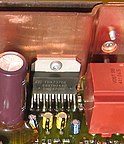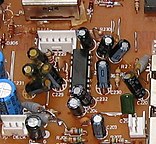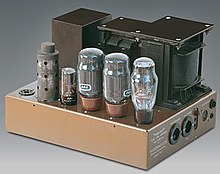Audio amplifier


An audio amplifier or sound amplifier is a broadband amplifier with as little distortion as possible for alternating voltages in the audible low frequency range of 20 Hz to 20,000 Hz or higher. Audio amplifiers contain an electronic circuit that amplifies small audio signals such as those of a pick-up , tuner or CD player in order to be able to reproduce them with greater power and usually continuously adjustable volume via one or more loudspeakers .
Basics
Audio amplifiers are power amplifiers . They are part of an electrical transmission chain, at the beginning and end of which there is a converted sound event. The signal sources usually deliver relatively small voltages with high internal resistance , while the loudspeakers with 4 or 8 ohms represent a very low-resistance load. Audio amplifiers therefore first amplify the input voltage before any frequency response corrections (e.g. using a tone control ) are made and the volume is adjusted. During the subsequent power amplification, the current is mainly amplified in order to be able to drive the low impedance of the load (loudspeaker).
An audio amplifier can be viewed as an electrical quadrupole whose output voltage U a is greater than the control voltage U e at the input. An operating voltage source ( power supply unit or battery ) provides the energy.
There is usually a linear relationship between output and input voltage (level and instantaneous value). For the voltage amplification factor v , the ratio between input and output voltage is specified as a factor.
Usually, however, the gain is specified as a gain measure. So with the unit Bel . Since the values in Bel would be too small, the gain is multiplied by "10" and the value is given in ( decibels ).
- .
Derived from:
- .
Breakdown by function
Audio amplifiers can be differentiated according to their function in an electroacoustic transmission chain:
- Integrated amplifiers are the "classic" and most widespread amplifiers in stereo systems for private use. They combine a preamplifier with input selector switch (s) for various audio sources and a volume control, usually a tone control for bass and treble, as well as the power amplifier or output stage to provide the power for the loudspeaker boxes in one device . With exceptions, they usually have no inputs for digital audio data, i.e. no digital-to-analog converter either .
- Preamplifiers prepare a very small input signal in such a way that its further processing or forwarding is simplified or only possible due to a higher voltage level and / or a more favorable output impedance .
- Distortion / equalization devices are amplifiers with specific deviations from the linear frequency response (e.g. emphasis , i.e. pre- emphasis and de-emphasis , RIAA equalizer) or linearity ( distortion device ). This is standard with preamplifiers for the signals of the pick-up of an analog record player (RIAA) as well as with analog cassette recorders . In the field of musical instruments, an effects device can also produce non-linear distortion if desired.
- Mixing consoles consist of a number of preamplifiers with adjustable amplification and adjustable frequency response for several audio signals , the output signals of which are additively combined. The level of the sum signal can also be influenced and is used, for example, to feed a power amplifier or a recording device.
- Intermediate amplifiers increase a level that is lowered by forwarding or are used to adapt the level or the impedance between different elements of the transmission chain.
- Control amplifiers contain control elements that adjust or regulate the level, frequency response, stereo balance, etc. Most of the time these are functionally identical to the preamplifier.
- Cutting amplifier, recording amplifier, modulation amplifier, etc. Ä. are the intermediate final link in a transmission chain before recording or transmission. Depending on the requirements, they have the properties of power amplifiers (e.g. modulation amplifiers in medium wave transmitters).
- Power amplifiers or power amplifiers are amplifiers which often require a relatively high input level for control and which in turn have few or no control elements. With the lowest possible output impedance, they provide the voltage for loudspeakers , cutting equipment (for record recording) or the modulation path (for transmitters).
- As a combination device, a receiver combines all the functions of the integrated amplifier described above with a radio receiver (tuner).
Other forms are e.g. B. the mixer amplifier.
Structure according to areas of application
Home electronics
The aim is to reproduce transmitted or stored audio signals. The focus is on economical production, design and, often, the highest level of freedom from distortion. Audio amplifiers for home use have few setting options, for example source selection, volume, balance, frequency response.
Studio technology
In the case of recording studios, operational reliability, durability, general robustness, insensitivity to electrical and magnetic interference, low noise, low distortion, a large transmission bandwidth and impulse fidelity are in the foreground. Furthermore, much more extensive control options are common compared to home electronics.
Modulation amplifier
To transmit audio signals as electromagnetic waves, high-frequency transmitters are used, onto which the signal to be transmitted must be modulated. For this purpose, modulation amplifiers are used which amplify the voltage of the audio signal in such a way that they can influence the high-frequency level of the transmitter in the signal cycle with amplitude modulation . This modulation often takes place towards the end of the high-frequency signal, so that considerable power may be required. Modulation amplifiers are reliable, low-distortion, protected against electrical interference and have a defined bandwidth.
Amplifier for musicians and stage
Audio amplifiers are used by musicians to amplify the sound of musical instruments. They often have characteristic features (e.g. guitar amplifiers , sometimes as tube amplifiers ) or are part of a feedback loop that specifically changes the original sound of the instrument. Such amplifiers are often connected to a pickup instead of a microphone. They have to withstand high loads due to frequent transport.
Monitor amplifiers are often integrated in monitor boxes ( active boxes ). Musicians need these loudspeakers when performing in order to hear themselves. In some cases, monitor amplifiers are integrated into mixing consoles - they are less powerful than the actual power amplifiers.
Power amplifiers for large stages and discos often convert electrical power in the kilowatt range (approx. 1… 6 kW). They are transistor or MOSFET amplifiers in push-pull or full-bridge circuit (see Amplifiers (electrical engineering) ). In order to reduce the voltage drop in the output transistors at high current (proportional to the power loss), so-called class G or -H amplifiers have been developed (classic AB amplifiers with stepped operating voltage or series pre-regulators in the operating voltage branches) and thus an efficiency of up to 80 % reached. Also, Class-D amplifier put in the PA area slowly, although further improvement in efficiency is connected by the D-operation with disadvantages, which mainly lie in the noise emission, intermodulation distortion and switching losses of the driver stage.
Communication / sound reinforcement
The transmission of human speech only requires a limited transmission range (e.g. 160 Hz to 5 kHz). This concerns z. B. trunked and cellular radio and wired telephony. For supplying several distributed speakers in electroacoustic systems (. Eg in an entire building) the output signals are high impedance (eg., 600 ohms) or high voltage (eg., 100 V) is transmitted, and in each speaker transformed down .
Breakdown by type of circuit
Single ended amplifier
This circuit has the longest history. Only one operating voltage is used and only one active component is required in the output stage. Low to medium negative feedback factors are common, so a small or medium number of amplifier stages is necessary. If there is a need for balanced inputs or outputs, these are balanced or unbalanced using special transformers. As power amplifiers, they are only known as tube amplifiers at higher powers. Single-ended power amplifiers have a low degree of efficiency - the feature is the constantly flowing supply current equal to the average load current. They are also known as the A power amplifier.
Push-pull amplifier
This structure is characteristic of amplifiers in semiconductor technology, but push-pull tube amplifiers are also built. Different topologies use either
- an operating voltage with a symmetrical output transformer (tube technology, early transistor amplifier) or an output coupling capacitor (Modern transistor amplifiers)
- two operating voltage sources with opposite polarity (only possible with transistor amplifiers). The output coupling capacitor can be omitted.
In modern transistor power amplifiers, numerous amplifier stages are used, which are mostly constructed as differential amplifiers and are directly (galvanically) coupled. The high gain of the open loop allows a strong, stabilizing and linearizing negative feedback. Asymmetrical and symmetrical inputs and outputs can be implemented with galvanic coupling, so that a lower limit frequency of 0 Hz is possible (see push-pull output stage ). Push-pull amplifiers are more efficient than single-ended amplifiers. A distinction is made between push-pull AB and push-pull B output stages, which differ in that they have a significant quiescent current at AB. A low quiescent current is more problematic in terms of achieving low transfer distortions (sinusoidal deviation when changing the current flow from one to the opposite output stage transistor).
Switching amplifier
Switching amplifiers are being built more and more frequently due to their high efficiency (small construction). They are also referred to as class D amplifiers or, somewhat inappropriately, as digital output stages and generate the useful signal using pulse-width modulated square-wave signals and subsequent filtering using an LC low-pass filter .
Structure according to active components
There are transistors or electron tubes used. Transistor amplifiers are often implemented as a monolithic integrated circuit or as a module using thick-film technology.
Transistor amplifier
Due to their low price, their small dimensions, their ability to be integrated, transistor amplifiers have the option of being able to use two different polarities of transistors (npn, pnp, n-channel, p-channel), operation with comparatively low operating voltages and the elimination of complex auxiliary voltage sources achieved a wide range of applications. There are bipolar and field-effect transistors are used. Often both types of transistors are combined.
Integrated circuits
Monolithic integrated circuits specially designed for audio applications can be found in power amplifiers from a few watts to around 100 watts output power. For higher outputs, they are mounted on a copper cooling flange. With them, compared to discrete power amplifiers, high stability of the operating point and a drastic reduction in component costs can be achieved. The power IC usually contain protective circuits against overheating and short circuits. They are often manufactured with two channels so that they can be used as stereo amplifiers or bridge amplifiers. Low -noise operational amplifiers are also used for low output levels ( preamplifiers , earphone amplifiers) .
Hybrid circuits
Hybrid power amplifiers include several transistor chips and passive components on a ceramic substrate, which also serves to dissipate the heat loss to a cooling surface.
Tube amplifier
Due to various disadvantages, electronic tubes in audio amplifiers have mostly been replaced by semiconductors today. They still have some importance in guitar amplifiers and high fidelity amplifiers of the high-end class.
Due to the specific advantages and disadvantages of semiconductor and tube amplifiers, there are combinations known as hybrids. One uses z. B. low-cost tube preamps with a comparatively low operating voltage and combines them with semiconductor output stages.
literature
- R. Beckmann: Manual of PA technology, basic component practice. 2nd edition, Elektor-Verlag, Aachen, 1990, ISBN 3-921608-66-X
- Roland Enders: The home recording manual. 3rd edition, Carstensen Verlag, Munich, 2003, ISBN 3-910098-25-8
- Gustav Büscher, A. Wiegemann: Little ABC of electroacoustics. 6th edition, Franzis Verlag, Munich, 1972, ISBN 3-7723-0296-3
- Fritz Kühne: Low-frequency amplifier with tubes and transistors. 13th edition, Franzis Verlag, Munich, 1970, ISBN 3-7723-0119-3
- Siegfried Wirsum: Nf tricks for the audio freak. 1st edition, Franzis Verlag GmbH, Munich, 1990, ISBN 3-7723-3321-4






